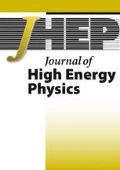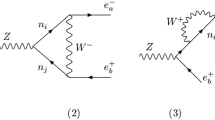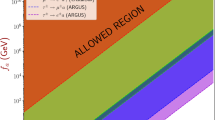Abstract
We present a new model based on the SU(3)⨂SU(2)⨂U(1) symmetry, in which there is a new consistent set of chiral fermion fields that renders the model free from anomalies. The new fermions do not share the usual family structure of the Standard Model and some of them have exotic electric charges, as the quarks X and Y with electric charge 5/3 and −4/3, respectively. Interestingly, the model contains a new heavy neutral lepton which may be a dark matter candidate. Two Higgs doublets are present in our construction, so that two CP even scalars are present in the model particle spectrum. One of them is similar to the Standard Model Higgs boson, while the other one couples mainly with the new exotic fermions. We performed a discovery analysis showing that the 8 TeV LHC can find the Y quark from single and pair production with masses from 300 GeV up to ~ 750 GeV. We also show that the new spectrum does not contribute significantly to the oblique EW parameters, and that dangerous flavor changing neutral currents are suppressed. Characteristic signatures from the other new fermions in the model are also commented.
Similar content being viewed by others
References
ATLAS collaboration, Observation of a new particle in the search for the Standard Model Higgs boson with the ATLAS detector at the LHC, Phys. Lett. B 716 (2012) 1 [arXiv:1207.7214] [INSPIRE].
CMS collaboration, Observation of a new boson at a mass of 125 GeV with the CMS experiment at the LHC, Phys. Lett. B 716 (2012) 30 [arXiv:1207.7235] [INSPIRE].
A. Djouadi and A. Lenz, Sealing the fate of a fourth generation of fermions, Phys. Lett. B 715 (2012) 310 [arXiv:1204.1252] [INSPIRE].
E. Kuflik, Y. Nir and T. Volansky, Implications of Higgs searches on the four generation Standard Model, arXiv:1204.1975 [INSPIRE].
J. Erler and P. Langacker, Precision constraints on extra fermion generations, Phys. Rev. Lett. 105 (2010) 031801 [arXiv:1003.3211] [INSPIRE].
M.S. Chanowitz, Bounding CKM mixing with a fourth family, Phys. Rev. D 79 (2009) 113008 [arXiv:0904.3570] [INSPIRE].
M. Bobrowski, A. Lenz, J. Riedl and J. Rohrwild, How much space is left for a new family of fermions?, Phys. Rev. D 79 (2009) 113006 [arXiv:0902.4883] [INSPIRE].
O. Eberhardt, A. Lenz and J. Rohrwild, Less space for a new family of fermions, Phys. Rev. D 82 (2010) 095006 [arXiv:1005.3505] [INSPIRE].
A.J. Buras et al., Patterns of flavour violation in the presence of a fourth generation of quarks and leptons, JHEP 09 (2010) 106 [arXiv:1002.2126] [INSPIRE].
W.-S. Hou and C.-Y. Ma, Flavor and CP-violation with fourth generations revisited, Phys. Rev. D 82 (2010) 036002 [arXiv:1004.2186] [INSPIRE].
A. Soni, A.K. Alok, A. Giri, R. Mohanta and S. Nandi, SM with four generations: selected implications for rare B and K decays, Phys. Rev. D 82 (2010) 033009 [arXiv:1002.0595] [INSPIRE].
CMS collaboration, Combined search for the quarks of a sequential fourth generation, Phys. Rev. D 86 (2012) 112003 [arXiv:1209.1062] [INSPIRE].
Particle Data Group collaboration, K. Nakamura et al., Review of particle physics, J. Phys. G 37 (2010) 075021 [INSPIRE].
F. Pisano and V. Pleitez, An SU(3) × U(1) model for electroweak interactions, Phys. Rev. D 46 (1992) 410 [hep-ph/9206242] [INSPIRE].
P. Frampton, Chiral dilepton model and the flavor question, Phys. Rev. Lett. 69 (1992) 2889 [INSPIRE].
A. Alves, E.R. Barreto and A. Dias, Jets plus same-sign dileptons signatures from fermionic leptoquarks at the LHC, Phys. Rev. D 86 (2012) 055025 [arXiv:1203.2342] [INSPIRE].
P.H. Frampton, P. Hung and M. Sher, Quarks and leptons beyond the third generation, Phys. Rept. 330 (2000) 263 [hep-ph/9903387] [INSPIRE].
R. Contino and G. Servant, Discovering the top partners at the LHC using same-sign dilepton final states, JHEP 06 (2008) 026 [arXiv:0801.1679] [INSPIRE].
G. Burdman, L. Da Rold, O. Eboli and R.D. Matheus, Strongly coupled fourth generation at the LHC, Phys. Rev. D 79 (2009) 075026 [arXiv:0812.0368] [INSPIRE].
J. Aguilar-Saavedra, Identifying top partners at LHC, JHEP 11 (2009) 030 [arXiv:0907.3155] [INSPIRE].
G. Cacciapaglia et al., Heavy vector-like top partners at the LHC and flavour constraints, JHEP 03 (2012) 070 [arXiv:1108.6329] [INSPIRE].
G. Cacciapaglia, A. Deandrea, L. Panizzi, S. Perries and V. Sordini, Heavy vector-like quark with charge 5/3 at the LHC, JHEP 03 (2013) 004 [arXiv:1211.4034] [INSPIRE].
S.S. Law, Constraints on exotic lepton doublets with minimal coupling to the Standard Model, JHEP 02 (2012) 127 [arXiv:1106.0375] [INSPIRE].
C.-K. Chua and S.S. Law, Phenomenological constraints on minimally coupled exotic lepton triplets, Phys. Rev. D 83 (2011) 055010 [arXiv:1011.4730] [INSPIRE].
J.E. Cieza Montalvo and P.P. de Queiroz Filho, Exotic heavy leptons predicted by extended models at the CERN LHC, Phys. Rev. D 66 (2002) 055003 [INSPIRE].
Y. Okada and L. Panizzi, LHC signatures of vector-like quarks, Adv. High Energy Phys. 2013 (2013) 364936 [arXiv:1207.5607] [INSPIRE].
M. Buchkremer, G. Cacciapaglia, A. Deandrea and L. Panizzi, Model independent framework for searches of top partners, arXiv:1305.4172 [INSPIRE].
D0 collaboration, V. Abazov et al., Experimental discrimination between charge 2e/3 top quark and charge 4e/3 exotic quark production scenarios, Phys. Rev. Lett. 98 (2007) 041801 [hep-ex/0608044] [INSPIRE].
CDF collaboration, T. Aaltonen et al., Exclusion of an exotic top quark with −4/3 electric charge using soft lepton tagging, Phys. Rev. Lett. 105 (2010) 101801 [arXiv:1006.4597] [INSPIRE].
ATLAS collaboration, Search for exotic same-sign dilepton signatures (b ′ quark, T 5/3 and four top quarks production) in 4.7 fb−1 of pp collisions at \( \sqrt{s} \) = 7 TeV with the ATLAS detector, ATLAS-CONF-2012-130, CERN, Geneva Switzerland (2012).
ATLAS collaboration, Search for a heavy top-quark partner in final states with two leptons with the ATLAS detector at the LHC, JHEP 11 (2012) 094 [arXiv:1209.4186] [INSPIRE].
CMS collaboration, Search for a heavy partner of the top quark with charge 5/3, CMS-PAS-B2G-12-003, CERN, Geneva Switzerland (2012).
W.J. Waalewijn, Calculating the charge of a jet, Phys. Rev. D 86 (2012) 094030 [arXiv:1209.3019] [INSPIRE].
K. Harigaya, S. Matsumoto, M.M. Nojiri and K. Tobioka, Search for the top partner at the LHC using multi-b-jet channels, Phys. Rev. D 86 (2012) 015005 [arXiv:1204.2317] [INSPIRE].
CDF collaboration, T. Aaltonen et al., Exclusion of exotic top-like quarks with −4/3 electric charge using jet-charge tagging in single-lepton tt events at CDF, arXiv:1304.4141 [INSPIRE].
C.T. Hill and E.H. Simmons, Strong dynamics and electroweak symmetry breaking, Phys. Rept. 381 (2003) 235 [Erratum ibid. 390 (2004) 553] [hep-ph/0203079] [INSPIRE].
M.E. Peskin and T. Takeuchi, Estimation of oblique electroweak corrections, Phys. Rev. D 46 (1992) 381 [INSPIRE].
H.-J. He, N. Polonsky and S.-F. Su, Extra families, Higgs spectrum and oblique corrections, Phys. Rev. D 64 (2001) 053004 [hep-ph/0102144] [INSPIRE].
Particle Data Group collaboration, J. Beringer et al., Review of particle physics (RPP), Phys. Rev. D 86 (2012) 010001 [INSPIRE].
M.S. Chanowitz, M. Furman and I. Hinchliffe, Weak interactions of ultraheavy fermions. 2, Nucl. Phys. B 153 (1979) 402 [INSPIRE].
D.A. Dicus and H.-J. He, Scales of fermion mass generation and electroweak symmetry breaking, Phys. Rev. D 71 (2005) 093009 [hep-ph/0409131] [INSPIRE].
V.D. Barger, K.-M. Cheung, T. Han and R. Phillips, Strong W + W + scattering signals at pp supercolliders, Phys. Rev. D 42 (1990) 3052 [INSPIRE].
J. Alwall, M. Herquet, F. Maltoni, O. Mattelaer and T. Stelzer, MadGraph 5: going beyond, JHEP 06 (2011) 128 [arXiv:1106.0522] [INSPIRE].
A. Alloul, J. D’Hondt, K. De Causmaecker, B. Fuks and M.R. de Traubenberg, Automated mass spectrum generation for new physics, Eur. Phys. J. C 73 (2013) 2325 [arXiv:1301.5932] [INSPIRE].
T. Sjöstrand, S. Mrenna and P.Z. Skands, PYTHIA 6.4 physics and manual, JHEP 05 (2006) 026 [hep-ph/0603175] [INSPIRE].
PGS 4: Pretty Good Simulation of high energy collisions webpage, http://www.physics.ucdavis.edu/~conway/research/software/pgs/pgs4-general.htm.
M.L. Mangano, M. Moretti, F. Piccinini and M. Treccani, Matching matrix elements and shower evolution for top-quark production in hadronic collisions, JHEP 01 (2007) 013 [hep-ph/0611129] [INSPIRE].
S. Bityukov and N. Krasnikov, On observability of signal over background, in Proceedings of the Workshop on Confidence Limits, CERN Yellow Report, CERN-2000-005, CERN, Geneva Switzerland (2000), pg. 219.
J. Aguilar-Saavedra, R. Benbrik, S. Heinemeyer and M. Pérez-Victoria, A handbook of vector-like quarks: mixing and single production, arXiv:1306.0572 [INSPIRE].
B.W. Lee and R.E. Shrock, Natural suppression of symmetry violation in gauge theories: muon-lepton and electron lepton number nonconservation, Phys. Rev. D 16 (1977) 1444 [INSPIRE].
J. Schechter and J. Valle, Neutrino decay and spontaneous violation of lepton number, Phys. Rev. D 25 (1982) 774 [INSPIRE].
H. Hettmansperger, M. Lindner and W. Rodejohann, Phenomenological consequences of sub-leading terms in see-saw formulas, JHEP 04 (2011) 123 [arXiv:1102.3432] [INSPIRE].
Author information
Authors and Affiliations
Corresponding author
Additional information
ArXiv ePrint: 1306.1275
Rights and permissions
About this article
Cite this article
Alves, A., Barreto, E.R., Camargo, D.A. et al. A model with chiral quarks of electric charges −4/3 and 5/3. J. High Energ. Phys. 2013, 129 (2013). https://doi.org/10.1007/JHEP07(2013)129
Received:
Revised:
Accepted:
Published:
DOI: https://doi.org/10.1007/JHEP07(2013)129




